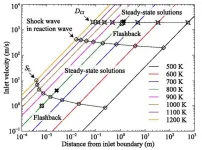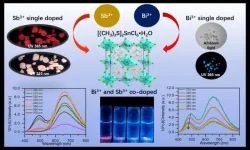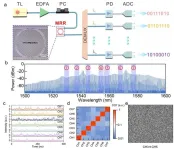(Press-News.org) A printable organic polymer that assembles into chiral structures when printed has enabled researchers to reliably measure the amount of charge produced in spin-to-charge conversion within a spintronic material at room temperature. The polymer’s tunable qualities and versatility make it desirable not only for less expensive, environmentally friendly, printable electronic applications, but also for use in understanding chirality and spin interactions more generally.
Spintronic devices are electronic devices that harness the spin of an electron, rather than its charge, to create energy-efficient current used for data storage, communication, and computing. Chiral materials refer to materials that cannot be imposed on their mirror image – think of your left and right hands, for example. If you lay your left hand over your right, the finger positions are reversed. That is chirality.
Chirality in spintronic materials allows designers to control the direction of spin within the material, known as the “chirality-induced spin selectivity (CISS)” effect. The CISS effect occurs when charge current flows along the chiral axis in a chiral material, producing spin – or charge-to-spin conversion – without needing ferromagnetic elements. Charge-to-spin conversion is necessary for memory storage in computing devices.
“We know that CISS-driven charge-to-spin conversion works efficiently in chiral semiconductors, but we want to know why,” says Dali Sun, associate professor of physics, member of the Organic and Carbon Electronics Lab (ORaCEL) at North Carolina State University and co-corresponding author of the work. “And an easy way to understand the puzzling mechanics of such a process is to reverse it, that is, to look at spin-to-charge conversion via the inverse CISS effect.”
Sun worked with Ying Diao, associate professor of chemical and biomolecular engineering at the University of Illinois Urbana-Champaign and co-corresponding author of the work, who developed printing processes to assemble conjugate organic polymers into chiral helical structures.
“Organic materials can transport spin over long distances, but they aren’t good at converting spin to charge, which is necessary for spintronic devices,” Diao says. “By making the structure of this material chiral we can leverage it to convert between spin and charge.”
“The CISS effect is created by putting a charge into a chiral spintronic device, but figuring out how efficiently the charge is converted to spin within the device is very challenging because it is hard to measure the produced spin in a quantitative way,” Sun says.
“The inverse chirality-induced spin selectivity effect, or ICISS, where you put spin into the device and measure the resulting current, has not been studied in organic polymers,” Sun says. “But it’s a lot easier to measure current than spin. So that’s what we did.”
Sun used microwave excitation as a spin-pumping technique to inject pure spin into the organic polymer and measure the resulting current.
The researchers found that spin lifetimes up to nanoseconds were achievable in the chiral organic polymer at room temperature, as opposed to the picosecond lifetimes in traditional spintronic materials.
“The beauty of this material – among other things – is its tunability,” Sun says. “We can change chirality, conductivity, and see how that affects spin or efficiency. We now have a way to really gain insight into why CISS-related spintronic devices work, which could help us design better and more efficient ones.”
“Polymer-based electronics are much less energy-intensive to fabricate than current electronics, and are easy to scale up for production,” Diao says. “Since polymer semiconductors are printable – they can be printed in the same way newspapers are – they would be ideal for portable, flexible and stretchable applications ranging from solar cells to new forms of computers.”
The work appears in Nature Materials and is supported by Air Force Office of Scientific Research, Multidisciplinary University Research Initiatives (MURI) Program under award number FA9550-23-1-0311; the Department of Energy; the National Science Foundation; the Office of Naval Research and the U.S. Air Force. Rui Sun of ORaCEL and Kyung Sun Park of Urbana-Champaign are co-first authors. Andrew H. Comstock and Aeron McConnell of NC State; Yen-Chi Chen and Axel Hoffmann of the University of Illinois Urbana-Champaign; Peng Zhang, and David Beratan of Duke University; Wei You of UNC-Chapel Hill; and Zhi-Gang Yu of Washington State University, also contributed to the work.
-peake-
Note to editors: An abstract follows
“Inverse Chirality-Induced Spin Selectivity Effect in Chiral Assemblies of π-Conjugated Polymers”
DOI: 10.1038/s41563-024-01838-8
Authors: Rui Sun, Andrew H. Comstock, Aeron McConnell, Dali Sun, North Carolina State University and ORaCEL; Yen-Chi Chen, Kyung Sun Park, Axel Hoffmann, Ying Diao, University of Illinois Urbana-Champaign; Peng Zhang, David Beratan, Duke University; Wei You, University of North Carolina Chapel Hill; Zhi-Gang Yu, Washington State University
Published: March 15, 2024 in Nature Materials
Abstract:
Coupling of spin and charge currents to structural chirality in non-magnetic materials, known as chirality-induced spin selectivity (CISS), is promising for application in spintronic devices at room temperature. Although the CISS effect has been identified in various chiral materials, its Onsager reciprocal process, the inverse CISS (ICISS) effect remains unexplored. Here we report the observation of the ICISS effect in chiral assemblies of π-conjugated polymers. Using spin-pumping techniques, the ICISS effect enables quantification of the magnitude of the CISS-driven longitudinal spin-to-charge conversion in different chiral polymers. By widely tuning conductivities and supramolecular chiral structures via a printing method, we found a very long spin relaxation time of up to several nanoseconds parallel to the chiral axis. Our demonstration of the ICISS effect opens possibilities for elucidating the puzzling interplay between spin and chirality, and opens a route for spintronic applications using printable chiral assemblies.
END
For Immediate Release
OAKLAND, Calif., March 15, 2024 — Innovation in trauma-informed health care is the core focus of a special section in today’s issue of The Permanente Journal. The special section features 13 articles that touch on this increasingly prominent approach and reaches into several diverse subdomains such as mental health, physical health, body size diversity and systems-level implementation. Workplace wellness, clinician training and medical school curricula related to trauma are also covered in the issue.
Trauma-informed health care has grown ...
The liver is not only the largest internal organ but also vital for human life as a metabolic center. It also possesses remarkable self-healing powers: even when large portions are removed, such as during surgery, they quickly regenerate in healthy individuals. However, in cases of repeated or chronic injury to the liver tissue, as caused by excessive alcohol consumption or viral hepatitis, this regenerative capacity fails. Scarring occurs, known as fibrosis, where liver cells are replaced by fibrous tissue. The liver hardens and becomes increasingly unable to perform its functions - in the worst case, this leads to liver failure.
To ...
It is well known that car safety equipment was originally designed with male-representative bodies in mind. This means women sitting in the front row are more likely to suffer severe or fatal injuries in the case of a crash. They are also more likely to be trapped in crashed cars.
Interested in the inequalities of car design and the resulting injuries, a team of researchers in the US has used trauma injury data from car crash victims to evaluate differences in injury patterns typical for males and females.
“We found that vehicle crash injury patterns and injury severity differ between men and women. We also show that women are arriving ...
Researchers led by Prof. WANG Bin at National Center for Nanoscience and Technology (NCNST) of the Chinese Academy of Sciences recently reported that strain generated at bubbles of 2D materials can benefit the catalytic activity of the hydrogen evolution reaction (HER). The study was published in Chem Catalysis.
Green hydrogen produced by electrochemical water splitting offers the potential to achieve carbon-neutral production processes. Catalysts play a crucial role in facilitating HER at the anode, making it a key component in the transition to a sustainable energy future. Transition metal dichalcogenides (TMDs), particularly MoS2, have drawn attention ...
In a study published on January 18, 2024 in the journal Physics of Fluids, researchers from Tohoku University theoretically linked ignition and deflagration in a combustion system, unlocking new configurations for stable, efficient combustion engines due to the possible existence of any number of steady-state solutions.
"This research directly tackles the challenge of reducing carbon dioxide emissions by enhancing the efficiency of combustion engines, a significant source of these emissions," said Youhi Morii from the ...
In 1879, Edison invented the incandescent lamp, which brought light to the night. In 1969, the first red light emitting diodes (LEDs) lamp came out. However, as the key to making white light bulbs, high-energy blue light has not been successfully commercialized. Until 1998, the Japan’s Nakamura Shoji made white LEDs, which marked the official entry of LEDs into the lighting era. LEDs have the advantages of high efficiency, environmental protection and energy saving. Metal halide perovskites (MHPs) have become a powerful candidate for new LEDs ...
In our digital networked society, random bit generators (RBGs) are vital for services and state-of-the-art technologies such as cryptographically secured communication, blockchain technologies, and quantum key distribution. An ever-increasing demand to improve the security of digital information has shifted the generation of random bits from sole reliance on pseudorandom algorithms to the use of physical entropy sources. Shannon’s theorem establishes that it is required for the ultimate security to achieve bit rate matching that of the true RBGs with that of the communication systems. For this purpose, optical chaos has been widely studied in the past decades as a means for the ...
Peer-reviewed / Modelling study / People
Embargoed access to the paper and contact details for authors are available in Notes to Editors at the end of the release.
Most comprehensive study to date finds the burden of nervous system (neurological) conditions is much greater than previously understood, with this diverse group of conditions affecting 43% of the world’s population (3.4 billion individuals) in 2021.
Neurological conditions were responsible for 443 million years of healthy life lost due to illness, disability, and premature death (disability-adjusted life years) in 2021, making them the ...
A positive relationship with a teacher at an early age may help children to feel more engaged with school, but not necessarily in the long term, new research shows.
The finding comes from a University of Cambridge study of more than 3,600 young people in Australia, using data gathered at several points between the ages of eight and 15. The students’ levels of school engagement – meaning their interest in school and willingness to learn – fluctuated during this period, especially during the ...
Liver disease specialists at the University of Chicago Medicine will soon begin prescribing a first-of-its-kind drug for treating advanced metabolic dysfunction-associated steatotic liver disease (MASLD) — formerly known as nonalcoholic fatty liver disease (NAFLD).
Resmetirom (to be sold under the brand name Rezdiffra), received FDA approval on March 14, 2024. It is the first medication approved for treating metabolic dysfunction-associated steatohepatitis (MASH), a more advanced stage of MASLD characterized by liver inflammation and scarring known as fibrosis.
“Until now, liver disease has ...



